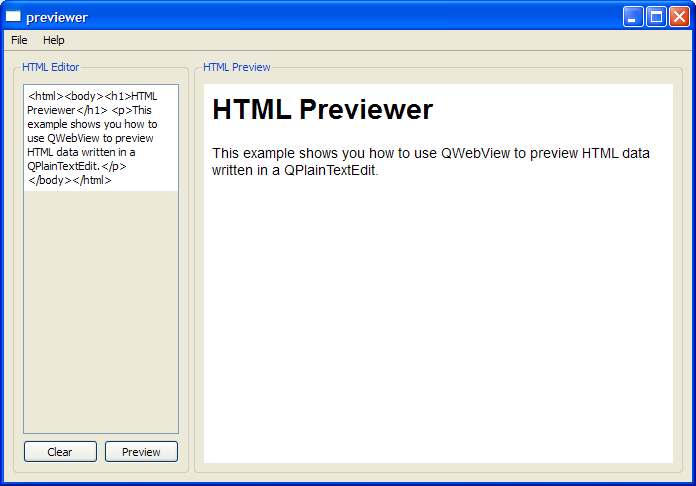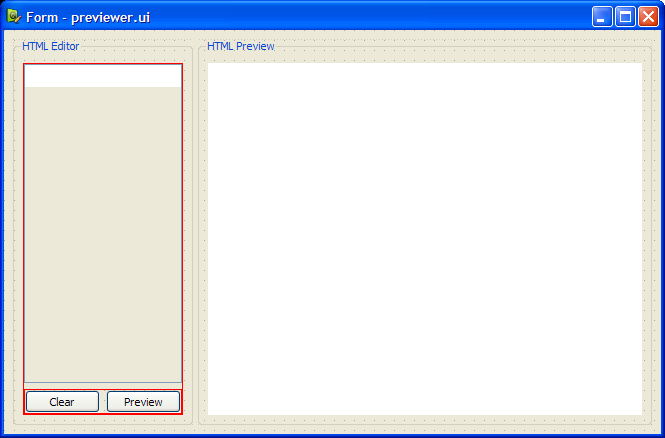
Before we begin, we create a user interface using
Qt Designer
。两
QGroupBox
objects - the editor group box and the previewer group box are separated by a
QSplitter
. In the editor group box, we have a
QPlainTextEdit
对象,
plainTextEdit
, and two
QPushButton
objects. In the previewer group box, we have a
QWebView
对象,
webView
.

The
Previewer
class is a subclass of both
QWidget
and Ui::Form. We subclass Ui::Form in order to embed the
Qt Designer
user interface form created earlier. This method of embedding forms is known as the
multiple inheritance approach
.
In our
previewer.h
file, we have a constructor and a slot,
on_previewButton_clicked()
.
class Previewer : public QWidget, public Ui::Form { Q_OBJECT public: Previewer(QWidget *parent = 0); void setBaseUrl(const QUrl &url); public slots: void on_previewButton_clicked(); private: QUrl baseUrl; };
The
Previewer
's constructor is only responsible for setting up the user interface.
Previewer::Previewer(QWidget *parent) : QWidget(parent) { setupUi(this); }
The
on_previewButton_clicked()
is a slot corresponding to the
previewButton
's
clicked()
signal. When the
previewButton
is clicked, we extract the contents of
plainTextEdit
, and then invoke the
setHtml()
function to display our contents as HTML.
void Previewer::on_previewButton_clicked() { // Update the contents in web viewer QString text = plainTextEdit->toPlainText(); webView->setHtml(text, baseUrl); // In mobile devices, change the tab #if defined Q_OS_SYMBIAN || defined Q_WS_HILDON || defined Q_WS_MAEMO_5 || defined Q_WS_SIMULATOR tabWidget->setCurrentWidget(tabHTMLPreview); #endif }
The
MainWindow
class for the Previewer example is a subclass of
QMainWindow
with a constructor and five private slots:
open()
,
openUrl()
,
save()
,
about()
and
updateTextEdit()
.
class MainWindow : public QMainWindow { Q_OBJECT public: MainWindow(); private slots: void open(); void openUrl(); void save(); void about(); void updateTextEdit();
The private objects in
MainWindow
are
centralWidget
, which is a
Previewer
对象,
fileMenu
,
helpMenu
和
QAction
对象
openAct
,
openUrlAct
,
saveAct
,
exitAct
,
aboutAct
and
aboutQtAct
.
private: Previewer *centralWidget; QMenu *fileMenu; QMenu *helpMenu; QAction *openAct; QAction *openUrlAct; QAction *saveAct; QAction *exitAct; QAction *aboutAct; QAction *aboutQtAct; void createActions(); void createMenus(); void setStartupText(); };
There are three private functions:
createActions()
,
createMenus()
and
setStartupText()
。
createActions()
and
createMenus()
functions are necessary to set up the main window's actions and assign them to the
File
and
帮助
menus. The
setStartupText()
function, on the other hand, displays a description about the example in its HTML Previewer window.
The
MainWindow
's constructor invokes
createActions()
and
createMenus()
to set up the
File
menu and
帮助
menu. Then, the
Previewer
对象,
centralWidget
, is set to the main window's central widget. Also, we connect
webView
's
loadFinished()
signal to our
updateTextEdit()
slot. Finally, we call the
setStartupText()
function to display the description of the example.
MainWindow::MainWindow() { createActions(); createMenus(); centralWidget = new Previewer(this); setCentralWidget(centralWidget); connect(centralWidget->webView, SIGNAL(loadFinished(bool)), this, SLOT(updateTextEdit())); setStartupText(); }
在
createActions()
function, we instantiate all our private
QAction
objects which we declared in
mainwindow.h
. We set the short cut and status tip for these actions and connect their
triggered()
signal to appropriate slots.
void MainWindow::createActions() { openAct = new QAction(tr("&Open..."), this); openAct->setShortcuts(QKeySequence::Open); openAct->setStatusTip(tr("Open an existing HTML file")); connect(openAct, SIGNAL(triggered()), this, SLOT(open())); openUrlAct = new QAction(tr("&Open URL..."), this); openUrlAct->setShortcut(tr("Ctrl+U")); openUrlAct->setStatusTip(tr("Open a URL")); connect(openUrlAct, SIGNAL(triggered()), this, SLOT(openUrl())); ...
The
createMenus()
function instantiates the
QMenu
items,
fileMenu
and
helpMenu
and adds them to the main window's
菜单栏
.
void MainWindow::createMenus() { fileMenu = menuBar()->addMenu(tr("&File")); fileMenu->addAction(openAct); fileMenu->addAction(openUrlAct); fileMenu->addAction(saveAct); fileMenu->addSeparator(); fileMenu->addAction(exitAct); menuBar()->addSeparator(); helpMenu = menuBar()->addMenu(tr("&Help")); helpMenu->addAction(aboutAct); helpMenu->addAction(aboutQtAct); }
The example also provides an
about()
slot to describe its purpose.
void MainWindow::about() { QMessageBox::about(this, tr("About Previewer"), tr("The <b>Previewer</b> example demonstrates how to " "view HTML documents using a QWebView.")); }
The
MainWindow
class provides two types of
打开
functions:
open()
and
openUrl()
。
open()
function opens an HTML file with
fileName
, and reads it with
QTextStream
. The function then displays the output on
plainTextEdit
. The file's name is obtained using
QFileDialog
's
getOpenFileName()
函数。
void MainWindow::open() { QString fileName = QFileDialog::getOpenFileName(this); if (!fileName.isEmpty()) { // read from file QFile file(fileName); if (!file.open(QIODevice::ReadOnly)) { QMessageBox::information(this, tr("Unable to open file"), file.errorString()); return; } QTextStream out(&file); QString output = out.readAll(); // display contents centralWidget->plainTextEdit->setPlainText(output); centralWidget->setBaseUrl(QUrl::fromLocalFile(fileName)); } }
The
openUrl()
function, on the other hand, displays a
QInputDialog
to obtain a URL, and displays it on
webView
.
void MainWindow::openUrl() { bool ok; QString url = QInputDialog::getText(this, tr("Enter a URL"), tr("URL:"), QLineEdit::Normal, "http://", &ok); if (ok && !url.isEmpty()) { centralWidget->webView->setUrl(url); } }
In order to save a HTML file, the
save()
function first extracts the contents of
plainTextEdit
and displays a
QFileDialog
to obtain
fileName
. Then, we use a
QTextStream
对象,
in
, to write to
file
.
void MainWindow::save() { QString content = centralWidget->plainTextEdit->toPlainText(); QString fileName = QFileDialog::getSaveFileName(this); if (!fileName.isEmpty()) { // save to file QFile file(fileName); if (!file.open(QIODevice::WriteOnly)) { QMessageBox::information(this, tr("Unable to open file"), file.errorString()); return; } QTextStream in(&file); in << content; } }
Earlier, in
MainWindow
's constructor, we connected
webView
's
loadFinished()
signal to our private
updateTextEdit()
slot. This slot updates the contents of
plainTextEdit
with the HTML source of the web page's main frame, obtained using
QWebFrame
's
toHtml()
函数。
void MainWindow::updateTextEdit() { QWebFrame *mainFrame = centralWidget->webView->page()->mainFrame(); QString frameText = mainFrame->toHtml(); centralWidget->plainTextEdit->setPlainText(frameText); }
To provide a description about the Previewer example, when it starts up, we use the
setStartupText()
function, as shown below:
void MainWindow::setStartupText() { QString string = "<html><body><h1>HTML Previewer</h1>" " <p>This example shows you how to use QWebView to" " preview HTML data written in a QPlainTextEdit.</p>" " </body></html>"; centralWidget->webView->setHtml(string); }
main()
函数
The
main()
function instantiates a
MainWindow
对象,
mainWindow
, and displays it with the
show()
函数。
int main(int argc, char * argv[]) { QApplication app(argc, argv); MainWindow mainWindow; #if defined Q_OS_SYMBIAN || defined Q_WS_HILDON || defined Q_WS_MAEMO_5 || defined Q_WS_SIMULATOR mainWindow.showMaximized(); #else mainWindow.show(); #endif return app.exec(); }
文件: